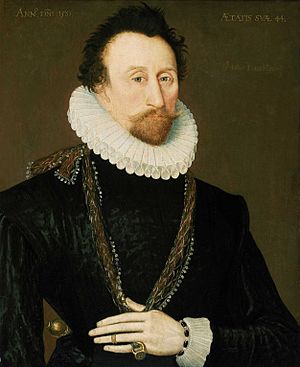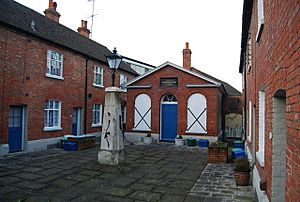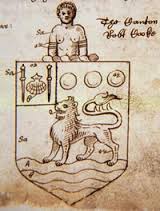John Hawkins (naval commander) facts for kids
Quick facts for kids
Sir John Hawkins
|
|
|---|---|

Portrait of John Hawkins at the National Maritime Museum, London
|
|
| Born | 1532 Plymouth, Devon, England |
| Died | 12 November 1595 (aged 62–63) off Puerto Rico, Spanish Main |
| Allegiance | |
| Service/ |
|
| Years of service | 1562–1595 |
| Commands held |
|
| Battles/wars | |
| Children | Richard Hawkins (1562–1622) |
Sir John Hawkins (1532 – 12 November 1595) was an important English naval leader. He was also a privateer, which means he was allowed by the government to attack enemy ships. Hawkins was also involved in the early English Atlantic slave trade.
He was considered the first English trader to make a lot of money from the Triangle Trade. This trade involved selling supplies to colonies that needed them. He also sold enslaved Africans to Spanish colonies in places like Santo Domingo and Venezuela.
Hawkins called himself "captain general." This showed he was in charge of his own ships and those from the English Royal Navy. He wanted to be different from other admirals who only did office work.
After his death, and that of his cousin Francis Drake, the Royal Navy became less strong for a while. But stories of his brave actions helped the Navy become powerful again later.
As Treasurer of the Navy from 1578 to 1595, Hawkins made big changes. He rebuilt old ships and designed new, faster ones. These ships were very important in the battle against the Spanish Armada in 1588.
Hawkins was a top seaman in 16th-century England. He was the main person who shaped the Elizabethan Navy. He served as a Vice-Admiral when the Spanish Armada was defeated in 1588. For his bravery, he was made a knight. He also planned a naval blockade to stop Spanish treasure ships from leaving Mexico and South America.
Contents
Early Life of John Hawkins
John Hawkins was born into a well-known family in Plymouth, Devon. We don't know his exact birth date, but it was likely between November 1532 and March 1533. He was the second son of William Hawkins, who was the first Englishman to sail to Brazil. His mother was Joan Trelawny.
When he was young, Hawkins might have worked for Spanish ambassadors. These ambassadors were arranging the marriage of Mary I of England and Philip II of Spain. Some Spanish people claimed King Philip himself knighted Hawkins for this work. Hawkins often called King Philip "my old master." The Spanish even knew him as Juan Aquines, showing how famous he was among them.
In 1555, another English trader named John Lok brought five men from present-day Ghana back to England. This happened after a trading trip to Guinea.
First Voyage and Slave Trade (1562–1563)
Queen Elizabeth I gave Hawkins permission to act as a privateer. This meant he could attack and take goods from Spanish ships. Even though England was not at war with Spain, this was allowed.
Hawkins formed a group of investors to fund trade with Africa. In 1562, he sailed with three ships to Sierra Leone. There, he captured about 300 enslaved people. He then took them to plantations in the Americas. He traded these enslaved people for valuable items like pearls, hides, and sugar.
This trade was very successful. When Hawkins returned to England, the Queen supported more voyages. She even gave Hawkins a special coat of arms. This coat of arms showed a male slave on it.
Second Voyage and Trade (1564–1565)
The Spanish usually wanted to control all trade themselves. However, a Spanish official named Diego Ruiz de Vallejo allowed Hawkins to trade enslaved people. Hawkins had to pay a tax of 7.5%. Another governor, Alonzo Bernaldez, said this trade was legal.
Hawkins traded at many ports in Venezuela and at Rio de la Hacha. He made good profits. He even received a certificate saying he behaved well. A public notary, Hernando de Heredia, wrote that Hawkins traded enslaved people and goods with local people.
However, Spanish officials in Santo Domingo later investigated these trades. They looked into officials who had dealt with Hawkins. They found that some officials had made unfair deals about the slave trade. Hawkins had visited Venezuelan ports before, trading many enslaved people and goods.
After his business, Hawkins needed water for his return trip to England. He sailed to the French colony of Fort Caroline in Florida. The French colonists there needed help. Hawkins traded his smallest ship and some supplies to them. In return, he received cannons, powder, and shot that they no longer needed. The supplies from Hawkins helped the French survive and prepare to go back home. The French leader, René Goulaine de Laudonnière, wrote that Hawkins was a very kind and helpful person.
Third Voyage (1567–1569)
Hawkins led another voyage that ended in a major battle. This was the Battle of San Juan de Ulúa in 1568. It was a fierce fight against the Spanish fleet.
In 1578, Hawkins became the Treasurer of the Navy. This was a very important job. He made many changes to how the Navy was run. Some people who benefited from the old system were not happy with his reforms.
In 1582, a rival named Sir William Wynter accused Hawkins of mismanaging money. A special group was formed to investigate these claims. This group included important figures like William Cecil, 1st Baron Burghley, Francis Walsingham, and Drake. They found that Hawkins was not corrupt. They also said that the Queen's Navy was in excellent condition.
Hawkins saved the Navy nearly £4000 each year. At the same time, he increased the pay for sailors. He also improved the design of galleon ships. He made them longer, able to carry more guns, and better at sailing against the wind.
Because of Hawkins's changes, the Navy became a faster and stronger fighting fleet. By 1587, the Navy had 23 ships and 18 smaller pinnaces. Historians say that Hawkins deserves much credit for making the Navy ready to fight the Spanish Armada.
Fighting the Spanish Armada
After the Spanish Armada was defeated, Hawkins wanted to stop Spain from getting rich again. He suggested taking Philip II's treasure from his colonies.
In 1589, Hawkins sailed with Francis Drake on a large military mission. This was called the Drake & Norris Expedition. One goal was to capture Spanish treasure ships coming from Mexico. A big victory might have made Philip II agree to peace.
However, this voyage did not succeed. The King of Spain was able to rebuild his navy. By the end of 1589, Spain had a strong fleet again. This fleet could protect its treasure ships coming home from America.

Tobacco and Its Introduction
Historians believe that Hawkins and his crew were among the first Europeans to see people using tobacco in the Americas. This happened during their voyages in 1562.
A record from his second voyage describes people in Fort Caroline (in Florida) smoking tobacco leaves around July 20, 1565. It says they used a cane and an earthen cup with fire and dried herbs to smoke. Hawkins and his men brought tobacco leaves and the idea of smoking back to England in 1565. However, smoking did not become popular in England until many years later.
Later Years and Death
Hawkins's son, Richard, was captured by the Spanish in 1593. With Sir Francis Drake, Hawkins gathered a fleet of 27 ships. Their goal was to attack the Spanish in the West Indies and rescue his son.
They left Plymouth on August 29, 1595. Bad weather and fights with the Spanish fleet made their efforts difficult. On November 12, 1595, John Hawkins died at sea. He passed away near Puerto Rico.
Historian Geoffrey Elton described Hawkins as a "founding-father of England's naval tradition." He said Hawkins was a strong leader with great intelligence. He was excellent as a sailor, administrator, fighter, and diplomat. He was also very charming.
Legacy and Memorials
The Royal Navy named a heavy cruiser ship HMS Hawkins after him. This ship was used from 1919 to 1947.
The Hospital of Sir John Hawkins Knight in Chatham, Kent is also named after Hawkins. There used to be a flyover (a bridge over a road) in Chatham named after him, but it was taken down in 2008.
Reconsidering Hawkins's Actions
In June 2006, Andrew Hawkins, who said he was a descendant of John Hawkins, publicly apologized. He apologized for John Hawkins's role in the slave trade. Andrew and 20 friends from a Christian charity knelt in chains. They did this in front of 25,000 Africans in Bakau, the Gambia. They asked for forgiveness for his ancestor's involvement in the slave trade.
The Vice-President of the Gambia Isatou Njie Saidy then removed the chains. This was a symbol of forgiveness and reconciliation.
In June 2020, Plymouth City Council made an announcement. Because of Hawkins's links to the slave trade, they planned to rename Sir John Hawkins Square. The square will be named after Jack Leslie. He was a black professional footballer who played for Plymouth Argyle.
See also
 In Spanish: John Hawkins para niños
In Spanish: John Hawkins para niños




